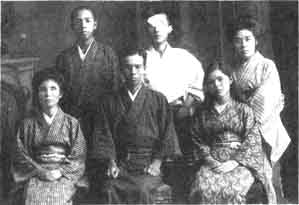
|
Abstract:
Extensive history of Bahá'í events and personages in Japan, 1914-1983.
Notes:
See also Errata for Traces that Remain and Japan Will Turn Ablaze.
Proofread by S. Sims and updated August 2019.
|
Chapter 11(1887-1959) In 1915 a Japanese schoolteacher in Tokyo, Mr. Naito, was instructing Dr. Augur in the Japanese language. Mr. Naito told his students that there was an American lady in Tokyo who was teaching a new religion. Four students came with him to see Miss Alexander, among them, Mr. Fukuta, who was eighteen years old. Mr. Fukuta said later he immediately felt that what Miss
 click here for larger image There is no date for this damaged, but interesting photograph. It was probably taken in 1917. It shows the first three Japanese to become Bahá'ís in Japan. Miss Yuri Mochizuki (later Mrs. Furukawa), right, sitting, Mr. Tokujiro Torii is sitting in the middle. Mr. Fukuta is behind him. Mrs. Torii, who became a Bahá'í in later years is standing. Mr. Torii's brother is standing on the left. Miss Asa Kosugi, who was a friend, is sitting on the left. Miss Kosugi, like Mr. Torii, was blind. She was the first blind woman to attend a university, and later became a prominent educator.
|
| METADATA | |
| Views | 274811 views since posted 2000; last edit 2025-01-28 14:57 UTC; previous at archive.org.../sims_traces_that_remain; URLs changed in 2010, see archive.org.../bahai-library.org |
| Language | English |
| Permission | author |
| History | Scanned 2000 by Jonah Winters; Formatted 2000 by Jonah Winters; Proofread 2000 by Barbara R. Sims. |
| Share | Shortlink: bahai-library.com/414 Citation: ris/414 |
|
|
|
|
Home
search Author Adv. search Links |
|